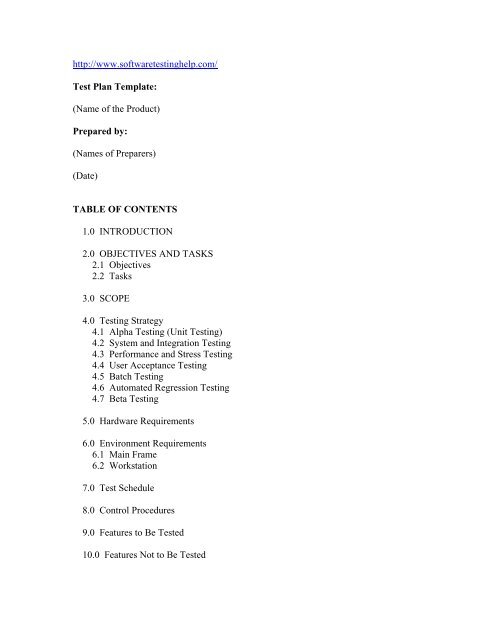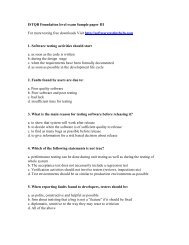Sample Test Plan Template - Software Testing Help
Sample Test Plan Template - Software Testing Help
Sample Test Plan Template - Software Testing Help
- No tags were found...
Create successful ePaper yourself
Turn your PDF publications into a flip-book with our unique Google optimized e-Paper software.
http://www.softwaretestinghelp.com/<br />
<strong>Test</strong> <strong>Plan</strong> <strong>Template</strong>:<br />
(Name of the Product)<br />
Prepared by:<br />
(Names of Preparers)<br />
(Date)<br />
TABLE OF CONTENTS<br />
1.0 INTRODUCTION<br />
2.0 OBJECTIVES AND TASKS<br />
2.1 Objectives<br />
2.2 Tasks<br />
3.0 SCOPE<br />
4.0 <strong>Test</strong>ing Strategy<br />
4.1 Alpha <strong>Test</strong>ing (Unit <strong>Test</strong>ing)<br />
4.2 System and Integration <strong>Test</strong>ing<br />
4.3 Performance and Stress <strong>Test</strong>ing<br />
4.4 User Acceptance <strong>Test</strong>ing<br />
4.5 Batch <strong>Test</strong>ing<br />
4.6 Automated Regression <strong>Test</strong>ing<br />
4.7 Beta <strong>Test</strong>ing<br />
5.0 Hardware Requirements<br />
6.0 Environment Requirements<br />
6.1 Main Frame<br />
6.2 Workstation<br />
7.0 <strong>Test</strong> Schedule<br />
8.0 Control Procedures<br />
9.0 Features to Be <strong>Test</strong>ed<br />
10.0 Features Not to Be <strong>Test</strong>ed
11.0 Resources/Roles & Responsibilities<br />
12.0 Schedules<br />
13.0 Significantly Impacted Departments (SIDs)<br />
14.0 Dependencies<br />
15.0 Risks/Assumptions<br />
16.0 Tools<br />
17.0 Approvals<br />
1.0 INTRODUCTION<br />
A brief summary of the product being tested. Outline all the functions at a high level.<br />
2.0 OBJECTIVES AND TASKS<br />
2.1 Objectives<br />
Describe the objectives supported by the Master <strong>Test</strong> <strong>Plan</strong>, eg., defining tasks and<br />
responsibilities, vehicle for communication, document to be used as a service level<br />
agreement, etc.<br />
2.2 Tasks<br />
List all tasks identified by this <strong>Test</strong> <strong>Plan</strong>, i.e., testing, post-testing, problem reporting, etc.<br />
3.0 SCOPE<br />
General<br />
This section describes what is being tested, such as all the functions of a specific product,<br />
its existing interfaces, integration of all functions.<br />
Tactics<br />
List here how you will accomplish the items that you have listed in the "Scope" section.<br />
For example, if you have mentioned that you will be testing the existing interfaces, what<br />
would be the procedures you would follow to notify the key people to represent their<br />
respective areas, as well as allotting time in their schedule for assisting you in<br />
accomplishing your activity<br />
4.0 TESTING STRATEGY<br />
Describe the overall approach to testing. For each major group of features or feature<br />
combinations, specify the approach which will ensure that these feature groups are
adequately tested. Specify the major activities, techniques, and tools which are used to<br />
test the designated groups of features.<br />
The approach should be described in sufficient detail to permit identification of the major<br />
testing tasks and estimation of the time required to do each one.<br />
4.1 Unit <strong>Test</strong>ing<br />
Definition:<br />
Specify the minimum degree of comprehensiveness desired. Identify the techniques<br />
which will be used to judge the comprehensiveness of the testing effort (for example,<br />
determining which statements have been executed at least once). Specify any additional<br />
completion criteria (for example, error frequency). The techniques to be used to trace<br />
requirements should be specified.<br />
Participants:<br />
List the names of individuals/departments who would be responsible for Unit <strong>Test</strong>ing.<br />
Methodology:<br />
Describe how unit testing will be conducted. Who will write the test scripts for the unit<br />
testing, what would be the sequence of events of Unit <strong>Test</strong>ing and how will the testing<br />
activity take place<br />
4.2 System and Integration <strong>Test</strong>ing<br />
Definition:<br />
List what is your understanding of System and Integration <strong>Test</strong>ing for your project.<br />
Participants:<br />
Who will be conducting System and Integration <strong>Test</strong>ing on your project List the<br />
individuals that will be responsible for this activity.<br />
Methodology:<br />
Describe how System & Integration testing will be conducted. Who will write the test<br />
scripts for the unit testing, what would be sequence of events of System & Integration<br />
<strong>Test</strong>ing, and how will the testing activity take place<br />
4.3 Performance and Stress <strong>Test</strong>ing<br />
Definition:<br />
List what is your understanding of Stress <strong>Test</strong>ing for your project.<br />
Participants:<br />
Who will be conducting Stress <strong>Test</strong>ing on your project List the individuals that will be<br />
responsible for this activity.
Methodology:<br />
Describe how Performance & Stress testing will be conducted. Who will write the test<br />
scripts for the testing, what would be sequence of events of Performance & Stress<br />
<strong>Test</strong>ing, and how will the testing activity take place<br />
4.4 User Acceptance <strong>Test</strong>ing<br />
Definition:<br />
The purpose of acceptance test is to confirm that the system is ready for operational use.<br />
During acceptance test, end-users (customers) of the system compare the system to its<br />
initial requirements.<br />
Participants:<br />
Who will be responsible for User Acceptance <strong>Test</strong>ing List the individuals' names and<br />
responsibility.<br />
Methodology:<br />
Describe how the User Acceptance testing will be conducted. Who will write the test<br />
scripts for the testing, what would be sequence of events of User Acceptance <strong>Test</strong>ing, and<br />
how will the testing activity take place<br />
4.5 Batch <strong>Test</strong>ing<br />
4.6 Automated Regression <strong>Test</strong>ing<br />
Definition:<br />
Regression testing is the selective retesting of a system or component to verify that<br />
modifications have not caused unintended effects and that the system or component still<br />
works as specified in the requirements.<br />
Participants:<br />
Methodology:<br />
4.7 Beta <strong>Test</strong>ing<br />
Participants:<br />
Methodology:<br />
5.0 HARDWARE REQUIREMENTS<br />
Computers<br />
Modems<br />
6.0 ENVIRONMENT REQUIREMENTS<br />
6.1 Main Frame<br />
Specify both the necessary and desired properties of the test environment. The
specification should contain the physical characteristics of the facilities, including the<br />
hardware, the communications and system software, the mode of usage (for example,<br />
stand-alone), and any other software or supplies needed to support the test. Also specify<br />
the level of security which must be provided for the test facility, system software, and<br />
proprietary components such as software, data, and hardware.<br />
Identify special test tools needed. Identify any other testing needs (for example,<br />
publications or office space). Identify the source of all needs which are not currently<br />
available to your group.<br />
6.2 Workstation<br />
7.0 TEST SCHEDULE<br />
Include test milestones identified in the <strong>Software</strong> Project Schedule as well as all item<br />
transmittal events.<br />
Define any additional test milestones needed. Estimate the time required to do each<br />
testing task. Specify the schedule for each testing task and test milestone. For each<br />
testing resource (that is, facilities, tools, and staff), specify its periods of use.<br />
8.0 CONTROL PROCEDURES<br />
Problem Reporting<br />
Document the procedures to follow when an incident is encountered during the testing<br />
process. If a standard form is going to be used, attach a blank copy as an "Appendix" to<br />
the <strong>Test</strong> <strong>Plan</strong>. In the event you are using an automated incident logging system, write<br />
those procedures in this section.<br />
Change Requests<br />
Document the process of modifications to the software. Identify who will sign off on the<br />
changes and what would be the criteria for including the changes to the current product.<br />
If the changes will affect existing programs, these modules need to be identified.<br />
9.0 FEATURES TO BE TESTED<br />
Identify all software features and combinations of software features that will be tested.<br />
10.0 FEATURES NOT TO BE TESTED<br />
Identify all features and significant combinations of features which will not be tested and<br />
the reasons.<br />
11.0 RESOURCES/ROLES & RESPONSIBILITIES
Specify the staff members who are involved in the test project and what their roles are<br />
going to be (for example, Mary Brown (User) compile <strong>Test</strong> Cases for Acceptance<br />
<strong>Test</strong>ing). Identify groups responsible for managing, designing, preparing, executing, and<br />
resolving the test activities as well as related issues. Also identify groups responsible for<br />
providing the test environment. These groups may include developers, testers, operations<br />
staff, testing services, etc.<br />
12.0 SCHEDULES<br />
Major Deliverables<br />
Identify the deliverable documents. You can list the following documents:<br />
- <strong>Test</strong> <strong>Plan</strong><br />
- <strong>Test</strong> Cases<br />
- <strong>Test</strong> Incident Reports<br />
- <strong>Test</strong> Summary Reports<br />
13.0 SIGNIFICANTLY IMPACTED DEPARTMENTS (SIDs)<br />
Department/Business Area Bus. Manager <strong>Test</strong>er(s)<br />
14.0 DEPENDENCIES<br />
Identify significant constraints on testing, such as test-item availability, testing-resource<br />
availability, and deadlines.<br />
15.0 RISKS/ASSUMPTIONS<br />
Identify the high-risk assumptions of the test plan. Specify contingency plans for each<br />
(for example, delay in delivery of test items might require increased night shift<br />
scheduling to meet the delivery date).<br />
16.0 TOOLS<br />
List the Automation tools you are going to use. List also the Bug tracking tool here.<br />
17.0 APPROVALS<br />
Specify the names and titles of all persons who must approve this plan. Provide space for<br />
the signatures and dates.<br />
Name (In Capital Letters) Signature Date
1.<br />
2.<br />
3.<br />
4.<br />
End.<br />
Ask me your <strong>Software</strong> <strong>Test</strong>ing, Job, Interview queries at www.softwaretestinghelp.com<br />
Passion For <strong>Test</strong>ing, Passion For Quality!






